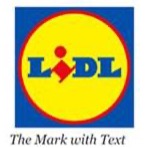On 19 March 2024, the Court of Appeal handed down its decision on the appeal in the Lidl v Tesco case ([2024] EWCA Civ 262), holding as follows.
| First instance (High Court) decision | Court of Appeal ruling |
| Copyright infringement | Overturned (appeal allowed) |
| Trade mark infringement | Upheld (appeal dismissed) |
| Passing off | Upheld (appeal dismissed) |
| Trade mark invalidity (for the mark depicting the background to the main Lidl logo) | Upheld (appeal dismissed) |
This post focusses on the Court of Appeal allowing the appeal against the first instance finding of copyright infringement. For more details on the first instance decision as a whole, see our prior Kluwer blog post here.
Background
The parties are the well-known supermarkets in the UK: Lidl and Tesco.
The subject of the dispute was Tesco’s Clubcard Prices signs (“CCP Signs”), as shown below. These were used as part of a marketing campaign by Tesco to indicate to customers which products were subject to discounted prices for Clubcard holders.
The CCP Signs

Lidl brought an action in the High Court against Tesco. By the time of trial, Lidl’s copyright claim was that the CCP Signs infringed the copyright subsisting in the Mark with Text shown below.
Lidl’s Logos

First instance
The first instance judge, Mrs Justice Joanna Smith, found that copyright subsisted in the Mark with Text and this was infringed by the CCP Signs.
On subsistence, the judge summarised Tesco’s argument as being that the “combination consists of insufficient skill and labour because it is too simple”, which she rejected. She noted that the artistic quality may not have been high, this did not preclude an artistic work from being original, and that “bringing together the Lidl text with the yellow circle and blue background was an act which involved skill and labour”. Accordingly, the Mark with Text was a protectable copyright work as an artistic work.
On infringement, the judge found that the similarities were sufficiently close to be more likely a result of copying than coincidence and so it was for Tesco to explain those similarities. Tesco failed to do so and Lidl successfully argued that the part copied (the blue background with the yellow circle) formed a substantial part of the copyright work (the Mark with Text), and so Tesco was held liable for copyright infringement.
Appeal
The process of creation of the Mark with Text is important context to the appeal. Essentially, Lidl explained that the Mark with Text was the product of a “three-stage evolution” [101] shown below, involving potentially different authors over roughly a 15-year period.
- Stage 1 – The stylised “Lidl” text only
- Stage 2 – The yellow circle with a red border was added to Stage 1 (the “Stage 2 Work”),
- Stage 3 – The blue square background was added to the Stage 2 Work (the “Stage 3 Work”)
The Stage 3 Work

Tesco’s appeal relied on two grounds. They claimed the first instance judge was wrong to find (1) the Stage 3 Work was original, and, in the alternative, (2) the CCP Signs reproduced a substantial part of the Stage 3 Work.
On the judge’s originality finding, Counsel for Tesco essentially argued that the contribution of the author of the Stage 3 Work was analogous to adding a blue background to Caravaggio’s Medusa, as shown below.

However, Arnold LJ found that the Stage 3 Work was “sufficiently original” to attract copyright protection, while noting that “scope of protection conferred […] is narrow” [194]. In doing so, he referred to the choices made by the author of the Stage 3 work as being:
- the shade of blue,
- the positioning of the Stage 2 Work centrally within the square, and
- the distance between the edges of the square and the edge of the Stage 2 Work [191].
Accordingly, Tesco’s objection on originality failed.
On the judge’s substantial part finding, Tesco argued on appeal that Tesco had not copied what was original to the author of the Stage 3 Work.
Arnold LJ agreed with Tesco and thus allowed the appeal. He explained that Tesco had not copied “at least two elements that make the Stage 3 Work original, namely the shade of blue and the distance between the circle and the square” [194]. Lidl had accepted that they could not complain about the yellow circle since it was only original to the Stage 2 Work, and not to the Stage 3 Work.
So, in short, the Court of Appeal found the Stage 3 Work was original, but was not infringed by the CCP Signs.
Comment
The Court of Appeal judgment highlights two important points of law.
Firstly, where the degree of creativity is low in a copyright work, the consequence is that the “scope of protection conferred by the copyright in that word is correspondingly narrow” [43].
So, while the case does helpfully demonstrate that brand owners may be able to rely on even relatively simplistic logos as copyright works, copyright protection for such simplistic logos may only capture close copies.
Secondly, the only protectable elements of a derivative work are those that are original over the antecedent work. Or, as Arnold LJ puts it in the judgment: “If A creates a first original work, B copies A’s work but adds sufficiently to it to create a second original work, and C copies from B’s work only the part created by A, then B has no claim for copyright infringement against C because that which has been copied by C is not original to B.” [44]
Accordingly, when it comes to copyright claims, it is important that brand owners (1) understand the process of creation of any “works” that they wish to rely on, and (2) recognise the original elements of each “work” if the work has been created in stages.
________________________
To make sure you do not miss out on regular updates from the Kluwer Copyright Blog, please subscribe here.


